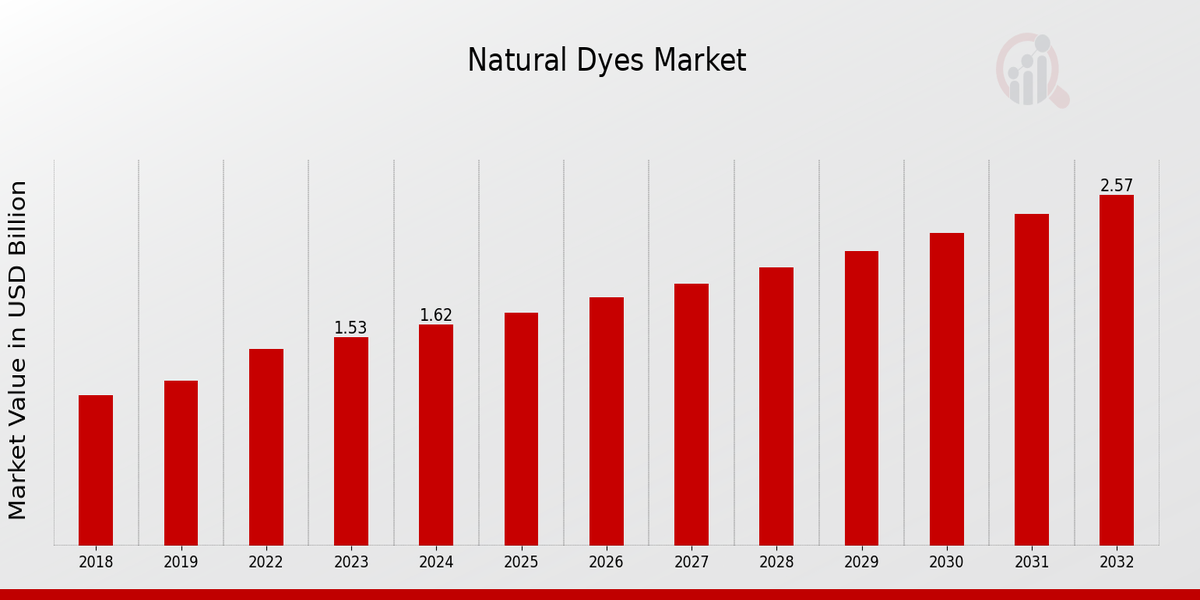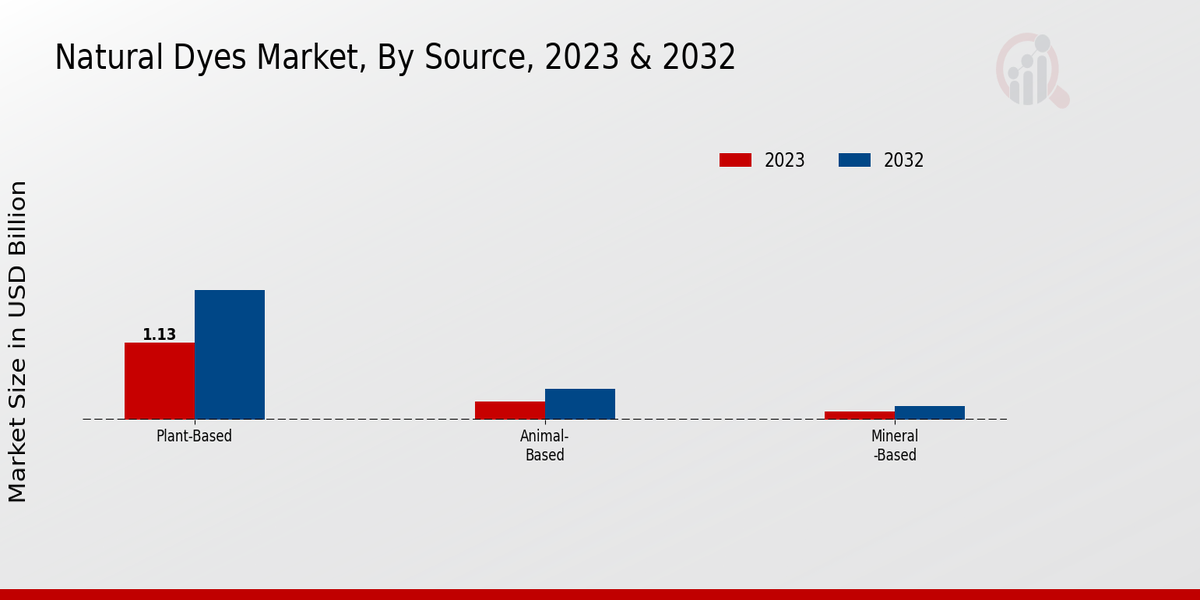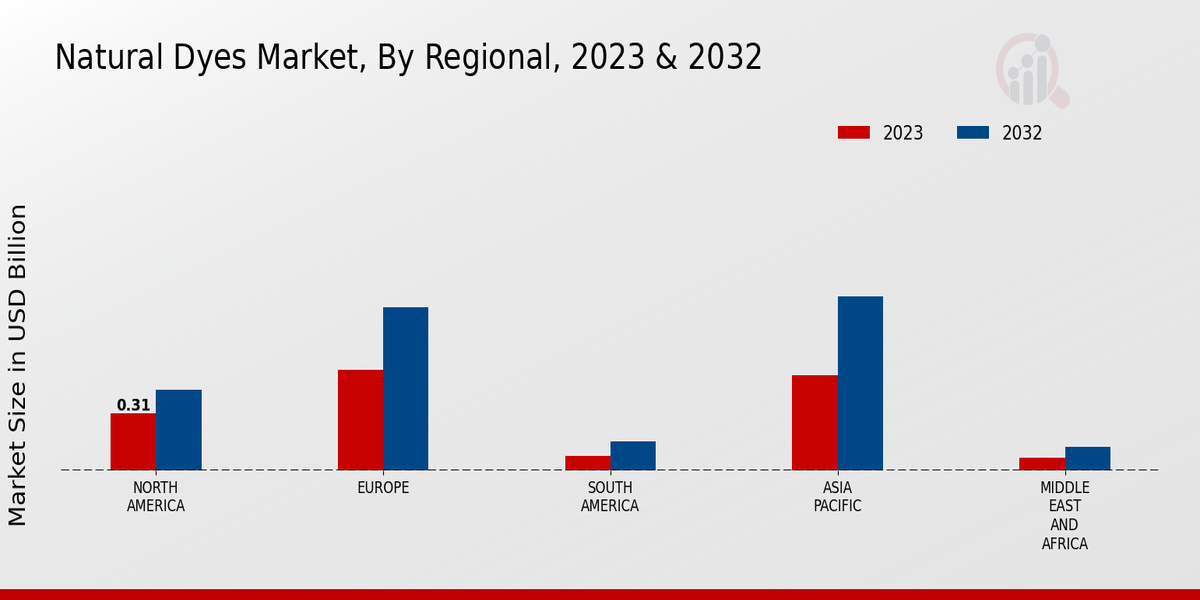Natural Dyes Market Overview
The Natural Dyes Market Size was estimated at 1.71 (USD Billion) in 2024. The Natural Dyes Market Industry is expected to grow from 1.82 (USD Billion) in 2025 to 3.06 (USD Billion) by 2034. The Natural Dyes Market CAGR (growth rate) is expected to be around 6.0% during the forecast period (2025 - 2034).
Key Natural Dyes Market Trends Highlighted
The market for natural dyes is witnessing an upswing in adoption, primarily driven by the rising demand for eco-friendly and sustainable products. Consumers are increasingly opting for natural alternatives to synthetic dyes, leading to a surge in demand for plant-based dyes in various industries, including textiles, cosmetics, and food. This shift towards eco-consciousness has created significant opportunities for natural dye manufacturers and suppliers to cater to evolving consumer preferences.In recent times, the market has seen a surge in the adoption of advanced extraction techniques, resulting in enhanced color yield and stability of natural dyes. This technological advancement has allowed manufacturers to produce a wider range of hues and shades, making natural dyes a viable alternative to synthetic counterparts. Additionally, the growing awareness of the harmful effects of synthetic dyes on human health and the environment has further fuelled the adoption of natural dyes.Overall, the market for natural dyes is poised for continued growth in the coming years, driven by the increasing demand for sustainable and eco-friendly products. The industry is expected to witness the emergence of new players and product innovations, catering to the evolving needs of consumers and industries alike.

Source: Primary Research, Secondary Research, MRFR Database and Analyst Review
Natural Dyes Market Drivers
-
Rising Demand from Textile Industry
The textile industry is one of the major consumers of dyes. In recent years, the demand for natural dyes has increased as consumers became more aware of the negative impact of synthetic ones on the environment and health. These dyes are extracted from various plants, minerals, and animals. The natural dyes are usually considered to be more ecofriendly and sustainable as compared to the synthetic dyes. Moreover, some of the natural dyes provide colors that are difficult to achieve with their synthetic opposites.Consequently, the growing demand from the textile industry is the strongest driver of the growth within the Natural Dyes Market Industry.
Growing Popularity of Eco-Friendly Products
Consumers are increasingly looking for products that are eco-friendly and sustainable. This trend is driving growth in the Natural Dyes Market Industry, as natural dyes are seen as a more sustainable alternative to synthetic dyes. Natural dyes are derived from renewable resources, and they do not produce the same harmful chemicals as synthetic dyes. In addition, natural dyes often have a lower environmental impact than synthetic dyes, as they do not require the use of harsh chemicals or energy-intensive processes.
Government Regulations on Synthetic Dyes
Government regulations on the use of synthetic dyes are becoming increasingly stringent as concerns about the environmental and health impacts of these dyes continue to grow. This is driving growth in the Natural Dyes Market Industry, as natural dyes are seen as a more sustainable and environmentally friendly alternative to synthetic dyes. Natural dyes are not subject to the same regulations as synthetic dyes, and they are generally considered to be safe for use in a variety of applications.
Natural Dyes Market Segment Insights
Natural Dyes Market Source Insights
The Natural Dyes Market is divided into three segments by source. The plant-based segment is the largest, with more than 60% of the market. Plant-based natural dyes are derived from plant sources, such as roots, leaves, flowers, and fruits. They are commonly used in the textile, food, and cosmetic industries due to the variety of colors and their eco-friendly nature. The animal-based segment is the smallest, with close to 20% of the market. Animal-based natural dyes are extracted from different animals, such as insects, mollusks, and fish.These natural dyes are known for their unusual colors and ability to stick to the materials, making them common in high-end textiles and artwork. The mineral-based segment is the smallest, with less than 10% of the market. Mineral-based natural dyes are produced from minerals such as iron oxide and copper sulfate. These are popular in ceramics, paints, and construction materials, as they do not lose their color and are very stable. The overall Natural Dyes Market is expected to nearly double in the next five years due to the increased demand for sustainable and eco-friendly products.The improved awareness of the negative impact of synthetic dyes on human health and the environment will spur the demand for natural dyes.

Source: Primary Research, Secondary Research, MRFR Database and Analyst Review
Natural Dyes Market Dye Form Insights
The Dye Form segment plays a crucial role in the Natural Dyes Market, offering diverse options for application in various industries. Powder, liquid, and paste forms each hold significant market shares and cater to specific requirements in textile dyeing, food, cosmetics, and other applications. Powdered dyes, with a market share of around 45% in 2023, are widely used due to their ease of storage, transportation, and handling. They are suitable for large-scale dyeing processes and offer good colorfastness. Liquid dyes, with a market share of approximately 30%, have gained popularity in recent years due to their convenience and ease of application, especially in smaller-scale operations.Paste dyes, accounting for nearly 25% of the market, provide high color intensity and are preferred for specialized applications requiring precise color matching. The market growth for all three Dye Form segments is expected to remain steady, with powder dyes projected to maintain their dominance while liquid and paste dyes continue to gain traction in specific applications.
Natural Dyes Market Application Insights
The Natural Dyes Market segmentation by Application includes Textiles, Leather, Paper, Cosmetics, and Food. The Textile segment is expected to hold the largest share in the Natural Dyes Market owing to the rising demand for eco-friendly and sustainable textiles. The Leather segment is another major application area, with natural dyes gaining popularity due to their ability to provide unique colors and patterns while maintaining the leather's natural texture. The Paper segment is also expected to witness significant growth due to the increasing demand for natural and biodegradable packaging materials.The Cosmetics segment is expected to grow steadily due to rising consumer awareness regarding the harmful effects of synthetic dyes on skin and hair. The Food segment is also expected to contribute to the Natural Dyes Market, driven by the growing demand for natural and organic food products.
Natural Dyes Market End-use Industry Insights
The end-use industry segment plays a crucial role in shaping the Natural Dyes Market revenue. Fashion Apparel industry holds a significant share, driven by the increasing demand for sustainable and eco-friendly textiles. The Home Furnishings sector is also witnessing growth due to the rising popularity of natural dyes in interior design. The automotive industry is exploring natural dyes as an alternative to synthetic dyes for vehicle interiors and exteriors. The Cosmetics Personal Care segment is gaining traction owing to the growing consumer preference for natural and organic products.The food Beverage industry is utilizing natural dyes to enhance the visual appeal and nutritional value of food products. The Natural Dyes Market segmentation offers insights into market growth and opportunities within each industry, enabling stakeholders to tailor their strategies and capitalize on emerging trends.
Natural Dyes Market Certification Insights
The Natural Dyes Market is segmented based on certification, which includes GOTS, OEKO-TEX, USDA Organic, and Fair Trade. The GOTS certification ensures that the natural dyes are produced in an environmentally and socially responsible manner, while the OEKO-TEX certification verifies that the dyes are free from harmful chemicals. The USDA Organic certification guarantees that the dyes are derived from organically grown plants, and the Fair Trade certification ensures that the dyes are produced in a fair and equitable manner. In 2023, the GOTS-certified natural dyes segment held the largest market share, accounting for approximately 35% of the Natural Dyes Market revenue.The OEKO-TEX-certified segment is projected to grow at the highest CAGR of 6.2% during the forecast period, owing to the increasing demand for sustainable and eco-friendly dyes in the textile industry.
Natural Dyes Market Regional Insights
The regional segmentation of the Natural Dyes Market provides insights into the market's performance in different geographic regions. North America is expected to dominate the market, driven by the increasing demand for sustainable and eco-friendly products. Europe is another significant region with a growing awareness of the harmful effects of synthetic dyes. APAC is projected to witness substantial growth due to the rising textile industry and consumer preference for natural products. South America and MEA are anticipated to contribute to the market's expansion with their growing economies and increasing demand for natural dyes in various industries.The Natural Dyes Market revenue in North America is projected to reach USD 760 million by 2024, while the APAC region is expected to reach USD 650 million by the same year. These statistics highlight the significant potential of regional markets in shaping the overall growth trajectory of the Natural Dyes Market.

Source: Primary Research, Secondary Research, MRFR Database and Analyst Review
Natural Dyes Market Key Players And Competitive Insights
Natural Dyes Market industry major players are extensively involved in mergers and acquisitions. For example, in 2021, Archroma, the leader in color and specialty chemicals, acquired M. Dohmen, one of the leading manufacturers of natural dyes. The acquisitions allow Natural Dyes Market players to extend their product range, reinforce their position in the market, and often gain access to new technologies. Additionally, investments in the research and development sector will play an important role in the development of the Natural Dyes Market as the technologies will continuously improve and new products will appear on the market with enhanced parameters and more suitable to various applications. Moreover, key players in the Natural Dyes Market are actively involved in cooperation with research institutions and universities to gain access to new technologies and expertise. Collaboration with various partners ensures knowledge exchange, innovations, and the development of new applications for natural dyes. Sustainability projects have also been launched by the top players in the Natural Dyes Market. Firms want to decrease their influence on the environment and serve as an example for others by introducing eco-friendly technologies and best practices nature across all applications. Manufacturers are strictly following the environmental regulations and certifications to satisfy the demand of consumers, who are growing increasingly concerned with sustainability and ethical aspects.The first major player in the Natural Dyes Market is Archroma, a specialty chemicals company that has its headquarters in Reinach, Switzerland. The company is a well-known producer of innovative and sustainable textile dyes, pigments, and chemicals. The company has a presence in more than 100 countries and offers a comprehensive line of natural dyes derived from plant and mineral sources. Archroma’s EarthColors is a line of natural dyes, which boast numerous environmental certificates and standards. The dyes are used in various applications, including textiles, leather, paper, and cosmetics.DyStar is a second major Natural Dyes Market player, which is a leading provider of dyes, chemicals, colorants, and services to the majority of market players. The company is based in Singapore but is represented throughout the world with operations in more than 50 countries. DyStar provides a wide line of natural dyes, which include Indigo, Madder, and Turmeric dyeing products. The company’s natural dyes are highly colorfast offering a wide array of possible tints reaching their highest quality. Production takes place in an environmentally friendly environment with adherence to all necessary environmental regulations and standards. DyStar’s natural dyes are used to produce sustainable and green textiles.
Key Companies in the Natural Dyes Market Include
Natural Dyes Market Industry Developments
The natural dyes market is projected to reach USD 2.57 billion by 2032, exhibiting a CAGR of 5.97% during the forecast period (2024-2032). Rising consumer awareness of the harmful effects of synthetic dyes on health and the environment is driving demand for natural dyes. Moreover, the growing popularity of eco-friendly and sustainable products is further propelling market growth. Key industry participants are focusing on research and development to improve the colorfastness and performance of natural dyes, which is expected to create new opportunities in the coming years. Recent developments include the launch of new natural dye-based products by major brands such as Patagonia and Eileen Fisher, as well as the increasing adoption of natural dyes in the textile, food, and cosmetic industries.
Natural Dyes Market Segmentation Insights
-
Natural Dyes Market Source Outlook
-
Natural Dyes Market Dye Form Outlook
-
Natural Dyes Market Application Outlook
-
Natural Dyes Market End-use Industry Outlook
-
Natural Dyes Market Certification Outlook
-
Natural Dyes Market Regional Outlook
| Report Attribute/Metric |
Details |
| Market Size 2024 |
1.71 (USD Billion) |
| Market Size 2025 |
1.82 (USD Billion) |
| Market Size 2034 |
3.06 (USD Billion) |
| Compound Annual Growth Rate (CAGR) |
6.0% (2025 - 2034) |
| Report Coverage |
Revenue Forecast, Competitive Landscape, Growth Factors, and Trends |
| Base Year |
2024 |
| Market Forecast Period |
2025 - 2034 |
| Historical Data |
2020 - 2024 |
| Market Forecast Units |
USD Billion |
| Key Companies Profiled |
Lanxess, Teijin, Archroma, DyStar, Sensient Technologies, Sumitomo Chemical, Genencor International, BASF, Evonik, Milliken Company, Nippon Kayaku, Clariant, Toray, Huntsman |
| Segments Covered |
Source, Dye Form, Application, End-use Industry, Certification, Regional |
| Key Market Opportunities |
1 Growing demand for sustainable textiles2 Increasing consumer preference for natural products3 Government regulations favoring eco-friendly practices4 Technological advancements in extraction and application techniques |
| Key Market Dynamics |
Increased consumer preference and growing demand from textile industry sustainability concerns technological advancements. |
| Countries Covered |
North America, Europe, APAC, South America, MEA |
Frequently Asked Questions (FAQ) :
The natural dyes market size was valued at 1.82 billion U.S. dollars in 2025 and is projected to reach 3.06 billion U.S. dollars by 2034, exhibiting a CAGR of 6.0% during the forecast period (2025-2034).
Asia-Pacific is expected to hold the largest market share and is projected to grow at the highest CAGR during the forecast period. The growth in this region can be attributed to the increasing demand for natural and sustainable products, particularly in countries like India and China.
Natural dyes find applications in various industries, including textiles, food, cosmetics, and pharmaceuticals. In the textile industry, natural dyes are used to color fabrics, yarns, and fibers. In the food industry, they are used as natural food colorants to enhance the visual appeal of food products. In cosmetics, they are used to color lipsticks, eye shadows, and other makeup products. In pharmaceuticals, they are used as active ingredients in herbal medicines and supplements.
Key players operating in the natural dyes market include Archroma, DyStar Group, Huntsman Corporation, and Naturex. These companies offer a wide range of natural dyes and cater to various industries.
The natural dyes market faces challenges such as the availability of raw materials, consistency in color and quality, and competition from synthetic dyes. Synthetic dyes are often cheaper and easier to produce, which can make it difficult for natural dyes to compete on price.
The natural dyes market has significant growth opportunities due to the increasing consumer demand for natural and sustainable products. The growing awareness of the harmful effects of synthetic dyes on the environment and human health is also driving the demand for natural dyes.
Key trends in the natural dyes market include the development of new and innovative natural dyes, the use of natural dyes in combination with synthetic dyes to achieve specific color effects, and the increasing adoption of natural dyes by major brands and retailers.
The COVID-19 pandemic had a negative impact on the natural dyes market in the short term due to disruptions in the supply chain and reduced demand from key industries such as textiles and cosmetics. However, the market is expected to recover in the long term as consumers become more aware of the benefits of natural dyes.
Regulatory factors affecting the natural dyes market include restrictions on the use of certain synthetic dyes in textiles and food products. These regulations vary by country and region, and manufacturers must comply with the specific regulations applicable to their target markets.
The future outlook for the natural dyes market is positive. The market is expected to continue to grow in the coming years, driven by the increasing demand for natural and sustainable products. Innovation in the development of new and improved natural dyes is also expected to drive market growth.

















